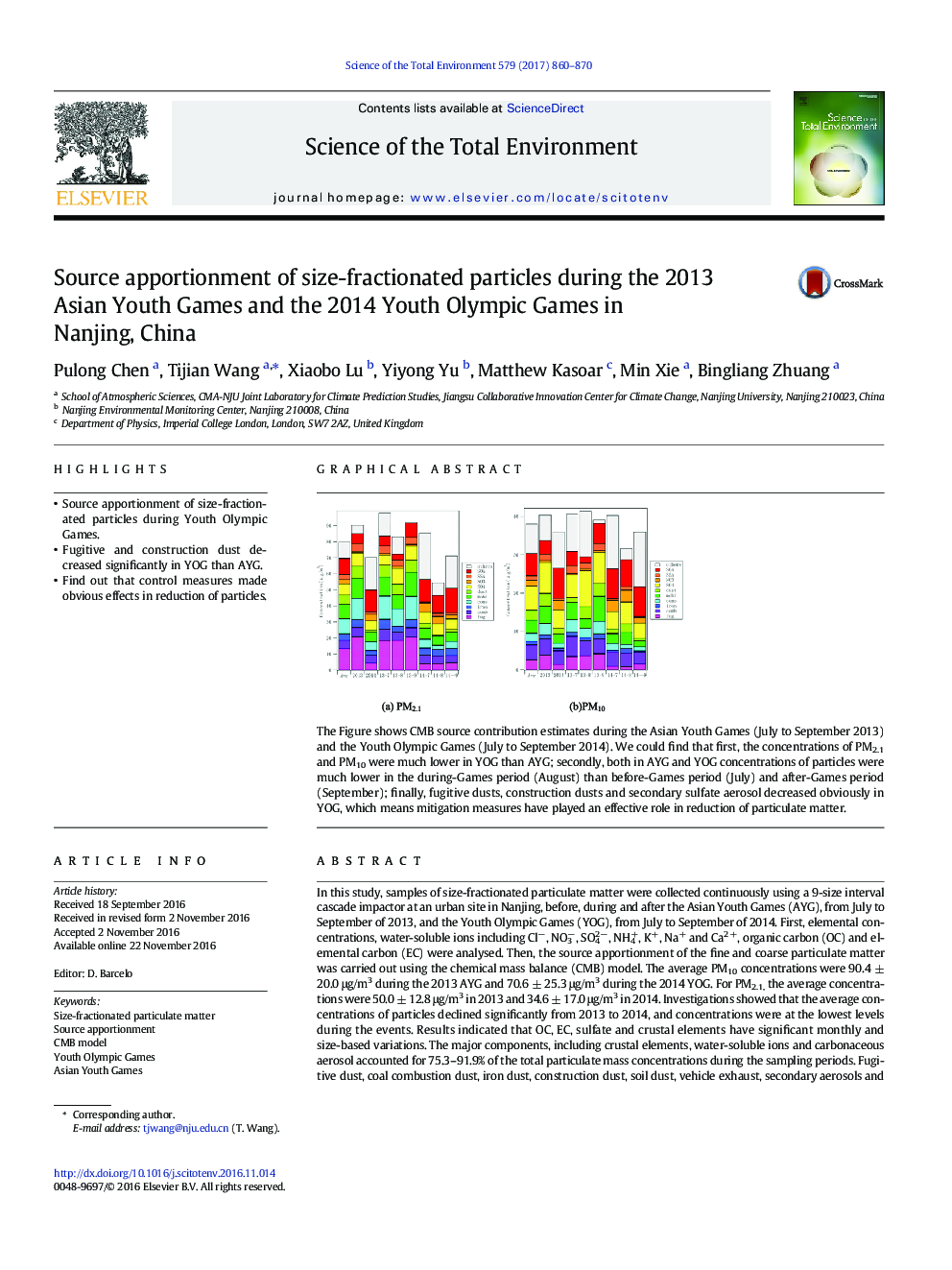| کد مقاله | کد نشریه | سال انتشار | مقاله انگلیسی | نسخه تمام متن |
|---|---|---|---|---|
| 5751440 | 1619712 | 2017 | 11 صفحه PDF | دانلود رایگان |
- Source apportionment of size-fractionated particles during Youth Olympic Games.
- Fugitive and construction dust decreased significantly in YOG than AYG.
- Find out that control measures made obvious effects in reduction of particles.
In this study, samples of size-fractionated particulate matter were collected continuously using a 9-size interval cascade impactor at an urban site in Nanjing, before, during and after the Asian Youth Games (AYG), from July to September of 2013, and the Youth Olympic Games (YOG), from July to September of 2014. First, elemental concentrations, water-soluble ions including Clâ, NO3â, SO42 â, NH4+, K+, Na+ and Ca2 +, organic carbon (OC) and elemental carbon (EC) were analysed. Then, the source apportionment of the fine and coarse particulate matter was carried out using the chemical mass balance (CMB) model. The average PM10 concentrations were 90.4 ± 20.0 μg/m3 during the 2013 AYG and 70.6 ± 25.3 μg/m3 during the 2014 YOG. For PM2.1, the average concentrations were 50.0 ± 12.8 μg/m3 in 2013 and 34.6 ± 17.0 μg/m3 in 2014. Investigations showed that the average concentrations of particles declined significantly from 2013 to 2014, and concentrations were at the lowest levels during the events. Results indicated that OC, EC, sulfate and crustal elements have significant monthly and size-based variations. The major components, including crustal elements, water-soluble ions and carbonaceous aerosol accounted for 75.3-91.9% of the total particulate mass concentrations during the sampling periods. Fugitive dust, coal combustion dust, iron dust, construction dust, soil dust, vehicle exhaust, secondary aerosols and sea salt have been classified as the main emissions in Nanjing. The source apportionment results indicate that the emissions from fugitive dust, which was the most abundance emission source during the 2013 AYG, contributed to 23.0% of the total particle mass. However, fugitive dust decreased to 6.2% of the total particle mass during the 2014 YOG. Construction dust (14.7% versus 7.8% for the AYG and the YOG, respectively) and secondary sulfate aerosol (9.3% versus 8.0% for the AYG and the YOG, respectively) showed the same trend as fugitive dust, suggesting that the mitigation measures of controlling particles from the paved roads, construction and industry worked more efficiently during the YOG.
The Figure shows CMB source contribution estimates during the Asian Youth Games (July to September 2013) and the Youth Olympic Games (July to September 2014). We could find that first, the concentrations of PM2.1 and PM10 were much lower in YOG than AYG; secondly, both in AYG and YOG concentrations of particles were much lower in the during-Games period (August) than before-Games period (July) and after-Games period (September); finally, fugitive dusts, construction dusts and secondary sulfate aerosol decreased obviously in YOG, which means mitigation measures have played an effective role in reduction of particulate matter.237
Journal: Science of The Total Environment - Volume 579, 1 February 2017, Pages 860-870
